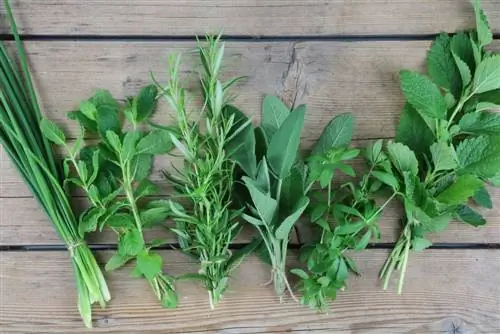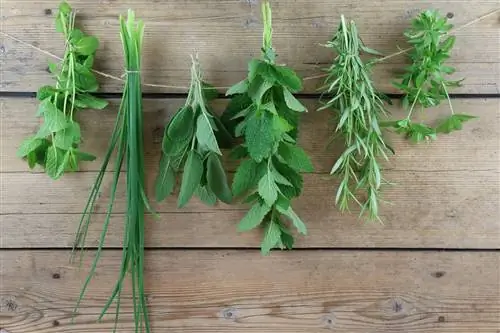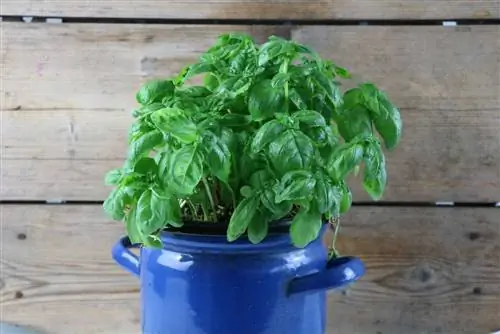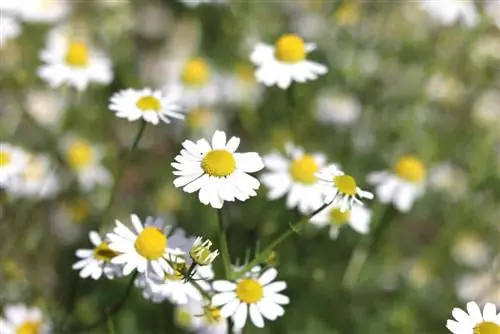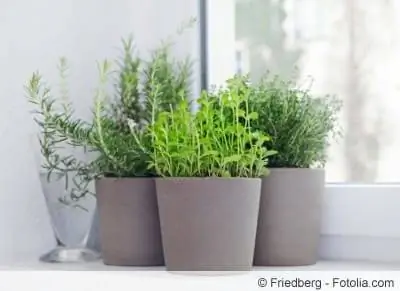- Author admin [email protected].
- Public 2023-12-17 03:39.
- Last modified 2025-01-24 12:45.
The terms herbs and spices always cause confusion. It seems rather coincidental when recipes for food and drinks mention herbs in one place and spices in another. In fact, it is neither an arbitrary nor a synonymous choice of words. Rather, there is a clear deviation. Stop asking yourself: What's the difference? Follow the explanations to use both terms precisely from now on.
Definition and examples
The legislature has an interest in ensuring that consumers find clear product names in the store. Thus, in a rather lengthy 'Guideline for spices and other seasoning ingredients', it is defined that those herbs are spices that have an influence on the taste and smell of food. The following distinction according to plant parts of spices and herbs clarifies the definition:
Spices are:
- Roots
- Seeds
- Flowers
- Buds
- Barks
- Fruits
- Flowers
- Onions
Herbs are:
- leaves
- Sprout
- Flowers
The individual items mentioned can be processed in whole or in parts, regardless of whether in fresh or dried form.
It follows:
Herbs can be considered spices - spices are not necessarily herbs.
The following examples are for clarification purposes:
- A soothing tea can be made from real chamomile. However, it does not season a dish. It is therefore a herbal plant, but not a spice.
- Capers are closed flower capsules of the caper family and give dishes a special taste. However, they are not herbs. The same applies to garlic cloves, which are part of the underground bulb and are therefore classified as aromatic plants.
In this context, what about substances that are used for seasoning but do not come from a plant? For this purpose, a generic term was introduced: seasonings. This includes, for example, table s alt, which is of crystalline origin. Sugar is also recorded here, honey or cooking oil, as well as all spices and culinary herbs.
The most important aromatic plants
If the plants in the kitchen garden are only suitable for seasoning dishes in the kitchen, then the planting plan should contain the following species:
Aniseed
The fruits of the annual plant are used. They are used to season bread, pastries, soups or sauerkraut. With a height of 60 centimeters, anise is also suitable for growing in pots on the balcony.
Basil

It is mainly the leaves that are added to dishes fresh or dried. The Mediterranean herb plant has conquered a regular place in the garden, on the balcony and on the windowsill. With a growth height of 20 to 60 centimeters, the annual basil is also available to chefs who do not have their own garden.
Wild garlic
The wild garlic leaves flavor pesto, herb quark or salads. The relative of chives and garlic is still often found in the wild. In your own herb garden, there is no risk of being confused with the poisonous lily of the valley or the spotted arum. With a growth height of 20 to 50 centimeters and a delicate white flower, this spice plant is a welcome guest in the hobby garden.
Savory
Without savory, stews or green beans are only worth half as much. The rubbed leaves are one of the classic spices in traditional cooking. Since the biennial plant is easy to care for, it is considered an ideal candidate for beginners.
Tip:
Chili is not a herb plant, but is a popular crop in allotments. The dried pods of the Cayenne variety provide the razor-sharp cayenne pepper, a spice that packs a punch.
Dill
It is preferably the shoot tips that give sauces, spreads, salad oil and pickles the final aromatic touch. The annual, herbaceous culinary herb thrives equally well in the greenhouse, outdoors and in the container. With a growth height of 30 to 75 centimeters and undemanding care, it is part of the standard equipment in private herb gardens.
Tarragon
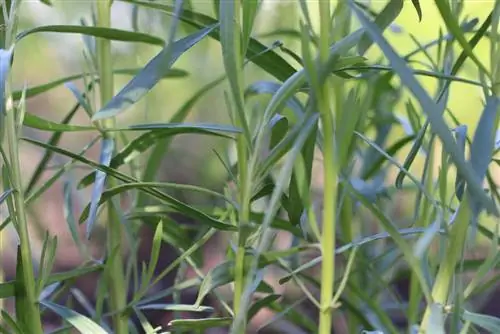
A spice plant with a subtle character that friends of French cuisine integrate into their herb garden comes from the Asteraceae family. Perennial tarragon reaches heights of up to 150 centimeters, making it less suitable for the balcony or windowsill. The young shoots are harvested shortly before flowering in order to season fish, poultry, soups or quark. In addition, tarragon is an essential ingredient in the famous Béarnaise sauce.
garlic
Wherever people like to cook and eat hearty food, garlic is a must. It is the onion that serves as a universal seasoning for chefs. Designed for perennial cultivation, the above-ground parts of the plant grow up to 90 centimeters in height. When a third of the leaves have withered, the garlic bulb can be harvested. In the countries of southern Europe, sprouts also flavor various regional speci alties.
Laurel
Dried bay leaves belong in every well-stocked spice rack. From here they migrate into red cabbage, white cabbage, goulash or brawn. Anyone who has ever experienced the serious difference to fresh laurel will immediately look for a way to plant the plant in their own garden as a hobby gardener. However, this is only possible where there is enough space for the shrub or tree, which can be up to 10 meters high.
Marjoram
The annual mint family is indispensable in both traditional and modern herb gardens. The leaves are used to season hearty dishes such as fried potatoes, meat speci alties, pea soup and poultry. As a Mediterranean spice plant, marjoram requires a warm, well-protected location in the herb garden. If this prerequisite is met, cultivation can be achieved even by an inexperienced hand.
Oregano

Another immigrant from the Mediterranean region has made it to the top of the hit list as a culinary herb. The crushed leaves of oregano are essential for giving a pizza its authentic flavor. Thanks to a manageable growth height of 20 to 80 centimeters, the spice plant is ready to hand on the windowsill for many housewives.
parsley
The traditional culinary herb comes with curled or smooth leaves that give a variety of dishes a special aroma. In the natural garden, the umbelliferous plant also scores points with its beneficial effect on beneficial insects such as lacewings, hoverflies, wasps and soft beetles. With a growth height of around 50 centimeters, parsley also likes to take up space in the herb garden on the balcony thanks to its decorative effect.
Tip:
The saffron crocus provides one of the most expensive spices in the world with its pistil threads. With its enchanting blossom in autumn, the onion flower also sets colorful accents, not just in the herb garden.
Chives
Perennial chives are an indispensable part of the herb garden. Only with this ingredient do dishes such as potato salad, omelettes, fish or meat turn out to perfection. Since the herbaceous spice plant grows to a maximum height of 50 centimeters, it is ideal for the bed and the pot on the windowsill.
Conclusion
All ingredients that have an influence on the taste or smell of food fall under the term spices. Within this classification there are a large number of plants whose leaves, flowers or sprouts provide the spice and are therefore classified as herbs. The general term spices includes other plants whose fruits, seeds, bark, roots or onions flavor a dish. The difference between herbs and spices is essentially based on the criterion of which plant parts are used in dishes.

